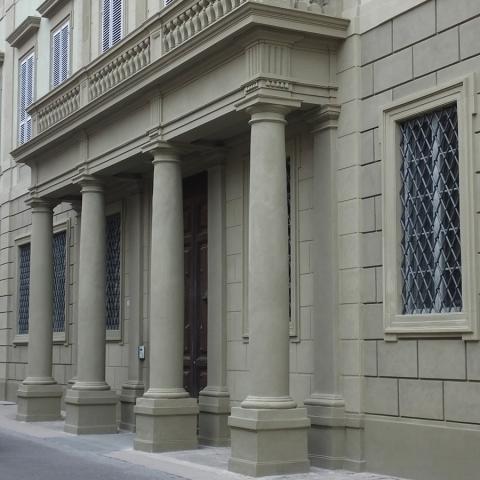Architetto, svolge attività professionale nel territorio pistoiese, realizzando opere nel restauro di beni monumentali
asuppressa
Ritrovata identità sulle tracce della storia
L'assetto delle facciate del palazzo vescovile di Pistoia, prima del restauro, risultava in condizioni di elevato degrado con gravi rischi per l'incolumità pubblica. Sulla facciata erano evidenti le tracce di serie di interventi, svolti prevalentemente nel secondo dopoguerra, non documentati e frutto di logiche operative improntate alla praticità. Queste opere avevano pesantemente mutato i connotati settecenteschi, ancora ben identificabili invece negli spazi interni del palazzo. La tinta che aveva opacizzato l'intero spartito, le ampie ricostruzioni di modellato eseguite in cemento oramai in fase di distacco avendo indebolito anche il retrostante labile supporto in pietra serena. La scelta che ha guidato l'intero intervento è stata quella di rimuovere le tracce (comunque ampiamente documentate) di tale prassi e ristabilire una coerenza tecnica – materica di ogni sua parte in grado di recuperare la valenza espressiva dell'ampio apparato decorativo.

TRAMANDARE IL SAPERE
Nei conventi domenicani le vicende delle biblioteche corrispondono spesso a quelle delle comunità che vi risiedono. L'Ordine fondato da san Domenico agli inizi del XIII secolo, di cui ricorre l'800° anniversario, ha vissuto sempre un rapporto fondamentale con i libri, importanti per lo studio quale componente essenziale per la predicazione.
La biblioteca è situata all'interno del complesso conventuale San Domenico di Pistoia che si articola con l'imponente mole della chiesa, i chiostri e l'ampio orto. Il convento ha costituito dagli inizi del XIII secolo un punto di riferimento essenziale per la vita religiosa e culturale della città. L'intervento che viene presentato riguarda il restauro e la messa a norma della sala deposito e della sala convegni, antico refettorio, con la realizzazione di sale di lettura aperte al pubblico e l'assetto sul quale si è intervenuti è quello scaturito dalla ristrutturazione del 1959 a seguito delle macerie della seconda guerra mondiale. Nonostante il grave danno subito a seguito del bombardamento, il fondo librario è stato progressivamente ricostituito, tanto da essere oggi stimato in circa 50.000 volumi.
CONSERVARE LE TRACCE DELLA STORIA
Il Palazzo dei Capitani della Montagna continua a rappresentare il fulcro intorno al quale si svolge il piccolo centro montano di Cutigliano in provincia di Pistoia. La mole chiusa e compatta dell'edificio, che rimanda ai palazzi pubblici sorti in Toscana durante i secoli XIII e XIV, nel corso del tempo è stata resa più articolata e meno austera dal progressivo inserimento degli stemmi dei Capitani che si sono succeduti nel governo di un'ampia parte della montagna pistoiese.
La policromia della terracotta, le variazioni stilistiche e cromatiche della pietra serena conferiscono alla facciata un valore narrativo a testimonianza della storia della cittadina e al contempo della sapienza artigianale dei vari laboratori artistici tradizionalmente operanti nell'area fiorentina e pistoiese.
Il restauro appena concluso ha rappresentato l'occasione per restituire integrità agli stemmi, oltre ad una ritrovata lettura di uno spartito architettonico che continua a comunicare e a catturare lo sguardo.
Oratorio del Ss. Crocifisso a Pistoia
Atmosfere barocche, polifonie di colori, uno spazio urbano ritrovato, stucchi, ornati e la storia di una delle più antiche famiglie di Pistoia, i Rutati, alla base di un’esperienza di restauro. Un piccolo Oratorio, eretto nell’adorazione del Crocifisso, racchiude, come un piccolo scrigno, una ricca iconografia delle tappe fondamentali della vita di Cristo e ripropone sulle facciate esterne la stessa ricchezza decorativa negli ornati e nella partizione geometrica. Anche la volta, sormontata da una copertura lignea, svela un piccolo spazio nascosto, un tempo utilizzato a colombaia dalle monache benedettine, testimonianza di momenti di vita quotidiana. Ma l’incuria ed il trascorrere del tempo offuscano il piccolo gioiello, appartato e dimenticato all’ombra del maestoso ex convento delle Monache da Sala. Il restauro appena concluso ha rappresentato l’occasione di una riscoperta oltre che la riqualificazione di uno spazio urbano all’interno del tessuto storico della città.
